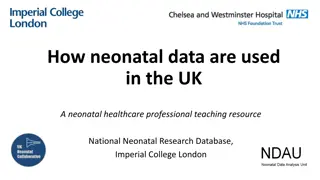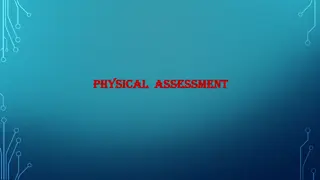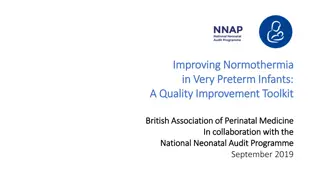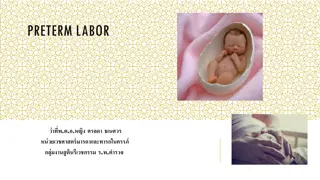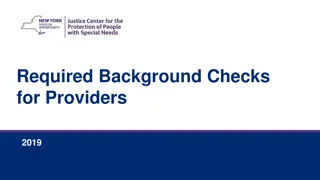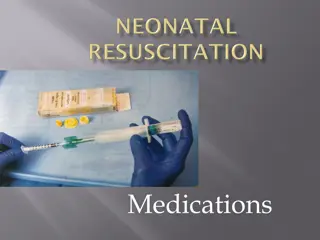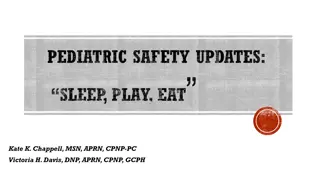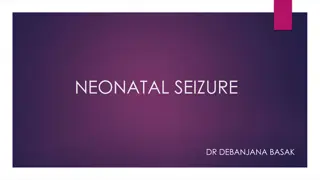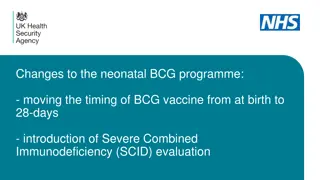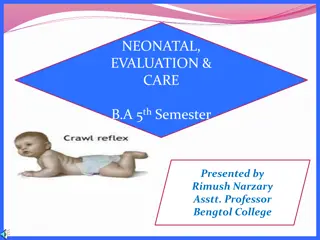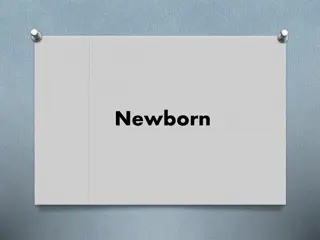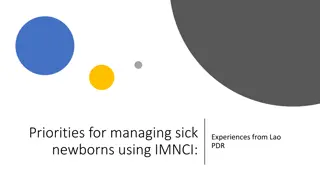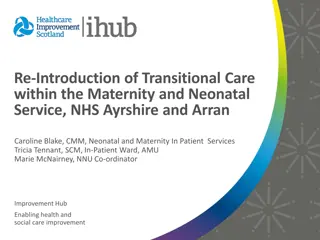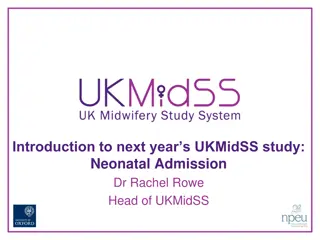Newborn Infant Physical Examination (NIPE) and Neonatal Checks Overview
Essential information on the NIPE screening update, neonatal checks, learning outcomes, eye examination, heart and CVS examination, and hips assessment for newborns. This content emphasizes early identification of abnormalities, top-to-toe examination, referral guidelines, and critical assessments to ensure infant health and development. Comprehensive guidance on eye, heart, and hips examinations is provided to aid healthcare professionals in thorough assessments and timely interventions.
Download Presentation

Please find below an Image/Link to download the presentation.
The content on the website is provided AS IS for your information and personal use only. It may not be sold, licensed, or shared on other websites without obtaining consent from the author. Download presentation by click this link. If you encounter any issues during the download, it is possible that the publisher has removed the file from their server.
E N D
Presentation Transcript
NIPE SCREENING UPDATE DR JENNY WRIGHT APRIL 2021
NEONATAL CHECKS What do you do ? Core features as per NIPE screening as per Gov.Uk state = eyes / cvs / hips and genitals. Just a screen will miss pathology at times so safety net with parents about developmental milestones Check growth in red book and ask re birth and antenatal / perinatal history.
NIPE SCREENING UPDATE LEARNING OUTOCOMES 1. To be able to identify abnormalities in the newborn before they impact upon the infants development and future health. - Done <72hrs within the hospital and 6-8wks in primary care. - JUST a screening exam so safety net with parents. 2. To be confident to complete top to toe examination looking specifically at eyes/ CVS / hips and genitals (also covers growth, hearing, tone, reflexes, minor abnormalities eg brachial cysts and talipes). 3. To know when to refer and who to refer to within appropriate timeframe
EYE EXAMINATION Problems related to low birth weight/ FH / infection- toxoplasmosis HSV or rubella / prematurity 2-3/10000 congenital cataracts Does your baby fixate when feeding / follow small movements? Cataracts are relatively common cause of blindness which are avoidable if treated early. Looks for squints (refer if persisting at 12wks) / cataracts / retinoblastoma / and aniridia (no iris) or colobomata (hole in iris) REFER urgently if missing red reflex / black area within red reflex or aniridia should be seen by 11wks
HEART AND CVS EXAMINATION 4-10/1000 have CHD and 25% of these critical Related to FH, Type I DM / SLE / Downs / Rubella or DH AEDs Serious CHD presents with tachycardia, apnoeas > 20s, central cyanosis , IC recession, FTT, thrills and murmurs , weak and asymmetrical femoral pulses (coarctation) Listen for murmurs 2ndICS left and right of sternum 4ICS left and apex as well as intrascapular for co-arctation) and femoral palpation DISCUSS WITH PAEDS IF CONCERNED AND REFER URGENTLY. Pathological murmurs usually harsh and heard over precordium with other clinical signs. If well and soft murmur identified likely to be benign- refer non urgently.
HIPS RF= FH / breech at CS or breech >36wks (before version)/multiple birth all should get USS <6wks. 1. Symmetry leg length and creases (although creases not always useful). 2. Galeazzi sign lie knees felxd and feet to bottom one knee lower than the other + 3. Barlows OUT(adduct and push femur posteriorly identifies if dislocatable). 4. Ortalanis IN (abduct and press anteriorly on femoral head- identifies if can be reduced). If positive signs dislocation refer urgently to Paeds Orthopaedics to be seen <10wks If RFs but USS not done by 8wk check send USS REQUEST URGENTLY 1-2/1000 (F>M) require surgery 5/1000 a harness
VIDEO https://youtu.be/SAzc69n6sms
TESTES AND GENITALS 1. Look for imperforate hymen. 2. Look for hypospadias 1: 250 malformation of foreskin / and or urethral opening refer by 6mnths 3. Cryptoorchidsim non descended testes up to 1:100 by 2-3mnths cannot feel within scrotal sac or v high and not descending risk testicular ca / torsion / infertility and related to FH / prematurity and low birth weight. If bilateral referred urgently <24hrs at neonatal check. OR <2wks to Paeds if picked up 6-8wk check. If unilateral and seen at 6wks check review 3-4mnths and refer if not descended to Paeds Urology they will see before 6mnths. Retractile testes high in scrotum and descend with warmth not an issue until puberty.
OTHER FEATURES TO CHECK Check growth and following centiles. Smiling / fixating / startling to noise. Tone / motor and reflexes moros and head control.- can be abnormal in CP / DMD Haemangiomas grow from 2-3wks and regress after 6mnths. When to refer (multiple >5 / overlying spinal cord / mouth lips / eyelids) but most go by 6yrs. AF should be patent (until around 18mnths) if impalpable refer sign of problems microcephaly. Cleft palate and tongue tie (check if feeding problems / growth deceleration) Plagiocephaly (usually positional and corrects with physio / correcting lie) Check limbs positional talipes vs congenital club foot. Umbilical hernias (v common often large but most correct over time 95% improve by 3yrs old refer then if sustained and large)
NIPE QUIZ 1. What does Barlows assessment test for whether hip joint is dislocatable or dislocated? 2. What proportion of babies are born with congenital hip dysplasia? 1-2/1000 or 4/1000? 3. Name 3 RF for dysplastic hips which should prompt referral for neonatal USS? 4. When would you refer a squint in a neonate? Immediately at birth / 8wks / at 12wks? 5. What is the significance of absent or partially absent red reflex? 6. When would you refer a persisting large umbilical hernia? Straight away / 6mnths / 2-3yrs? 7. What proportion of CHDs can lead to critical illness ? 50% / 10% / 25%? 8. What is the significance of a unilateral weak femoral arterial pulse? 9. When you would you ideally refer a baby with bilaterally non descended testes? Immediately / 6mnths or 2yrs? 10. When would you refer a child with a haemangioma?
ANSWERS 1. Barlows (OUT so dislocatable) 2. 1-2:1000 3. RF = multiple birth / Breech and FH 4. Squint refer > 12wks if not correcting 5. Loss red reflex = cataract / retinoblastoma? 6. Umbilical hernia usually resolve by 2-3yrs refer if v large after 2yrs of age 7. CHD 25% defects are critical. 8. Possible coarctation of aorta. 9. Refer unilateral non descended testis at around 4-6mnths 10. If multiple >5 or involving eyelids / lips / overlying spine.







